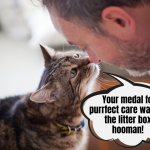Hey, fabCat – do you have a first-aid kit at home, filled with all the necessary medicine and bandages for unexpected accidents? Good job! And now a second question: do you have one for your cat? Though we, as Carers, always try to care for our cats the best we can, the truth is that a first-aid kit for cats is still a novelty for many households – if they have one, it’s often quite basic. Today we’ll find out what should actually be inside your cat’s first-aid kit and how to prepare it for the specific needs of your feline friends.
Cat’s first-aid kit – who needs it anyway?
You, fabCat! Everyone who’s ever had cats knows that they are able to get themselves into the strangest of troubles when you least expect it. Throwing up 10 minutes before Christmas dinner? Lack of appetite right as the hoomans are getting ready to leave for a week and leaving the cat under a pet sitter’s care? Or maybe a claw broke while the cat was trying to illegally scratch the sofa when the hooman wasn’t looking? There isn’t a cat who wouldn’t have at least one crazy accident story in their CV. And those are the situations we better get prepared for. Sometimes an emergency vet visit is a must but there are also times when we can help our pets right away before we put them into a kitty ambulance.
Items necessary in a cat’s first-aid kit
Let’s start with the basics: the accessories, bandages, and medicine that will be useful in a cat’s first-aid kit regardless of their age, health history, or luck for unexpected adventures. The first-aid kit doesn’t have to take up a lot of space or be stocked to the brim, but it should always be within reach. Why? Because it’s easier to get a small box from the kitchen cabinet than trying to pull out a big kit from under the bed or searching for a bandage that “was here, surely” when the cat needs immediate attention. A first-aid kit for cats is a MUST-HAVE!
What should you put in the first-aid kit?
- protective gloves (latex) – we don’t dress wounds without proper protection;
- dressings: you might need gauze pads (the smaller 5×5 cm and 9×9 cm are perfect for cats), elasticated bandages, paper band-aids, and standard vet wrap. Always match the size of your dressings to your pet’s needs so that you never need to cut them to size in an emergency;
- an antiseptic/disinfecting solution and saline solution;
- a thermometer – in the case of cats (and most animals) we must check their temperature quickly and precisely and do so by sticking the thermometer into their butts. It’s best if it’s a digital one with a quick response time so you don’t stress out the cat too much. Remember to always use a lubricant when checking the temperature (it could be liquid paraffin, a water-based lubricant, or even a simple cooking oil);
- scissors – for taking off the bandages it’s best to have surgical scissors at hand. If you have a long-haired cat, an extra set of grooming scissors might come in handy to trim some unruly fur in strategic places;
- tweezers and a tick hook – especially important if your cat has access to the garden, is an indoor/outdoor cat, or lives with pets who go outside;
- cotton swabs and pads – always handy when you want to clean the eyes and ears;
- ear and eye cleaning solution – if you don’t have them, saline solution will do fine;
- a spray with colloidal silver to speed up the wound healing process;
- emergency thermal blanket – in a situation where you need to quickly transport your cat to the vet, e.g. after an accident, a thermal blanket will help keep the kitty warm;
- a phone number to your vet clinic and a 24/7 clinic – it will be useful not just for you, but anyone who takes care of your cat when you’re away.
A second category of items found in a cat’s first-aid kit is medications and in this case, consulting with your vet is a must. If we’re administering any sort of medication to our cat, it’s always wise to do it after we talk to the vet (even on the phone) just to make sure that it is the situation the cat is in, it’s advised to give them that particular pill. Even medications that are deemed safe for cats could do more harm than good if used incorrectly.
What medications could be useful in a cat’s first-aid kit?
- a relaxant for tummy issues. For cats, it’s given for vomiting, diarrhea, and urinary problems.
- lactulose – for constipation or hairballs. It helps to clear the digestive tract and can cause diarrhea, but it doesn’t get absorbed by the body so it shouldn’t do any harm (careful with diabetic cats as lactulose is a sugar solution).
- activated carbon medicine – to help with diarrhea or suspected poisoning.
- probiotics and synbiotics to aid in diarrhea and constipation treatments as well as antibiotics treatments.
You might also need medication that was prescribed to your cat by their vet – they’d be different for diabetic cats, cats with kidney issues, or senior cats so there’s no point for us to list them.
When should you use the first-aid kit?
It’s obvious – the first-aid kit is supposed to come in handy in emergencies, accidents, and whenever you can’t get to the vet immediately. Situations like this can happen to any cat and any cat Carer, even if you’re very careful. But if you are prepared, you don’t have to fear them! And even though it’s difficult, regardless of what’s going on, staying calm and collected will help you not only make the best decision at the time but also keep the cat calm. and staying calm is what cats usually need – if we could bottle it up, we’d definitely put calmness into the top 5 items for a first-aid kit!
Have you ever had to use your cat’s first-aid kit, fabCats? What items and accessories do you think you should always have at hand? Share your ideas and tricks in the comments.




